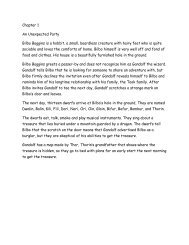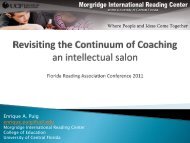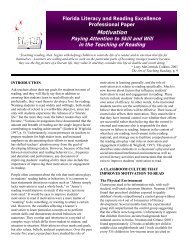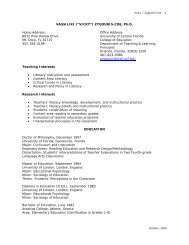compliance statement
compliance statement
compliance statement
Create successful ePaper yourself
Turn your PDF publications into a flip-book with our unique Google optimized e-Paper software.
Generating and Asking Questions<br />
This strategy involves readers asking themselves questions throughout the<br />
reading of a text. The ability of readers to ask themselves relevant questions as<br />
they read is especially valuable in helping them to integrate information, identify<br />
main ideas, and summarize information. Asking the right questions allows good<br />
readers to focus on the most important information in a text. 21<br />
Generating good questions may also lead readers to focus on problems with<br />
comprehension and to take actions to deal with these problems. 22<br />
Making Inferences<br />
This strategy requires readers to evaluate or draw conclusions from information<br />
in a text. Authors do not always provide complete descriptions of, or explicit<br />
information about a topic, setting, character, or event. However, they often provide<br />
clues that readers can use to “read between the lines”—by making inferences that<br />
combine information in the text with their background knowledge.<br />
It has been shown that when readers are taught how to make inferences, they<br />
improve their abilities to construct meaning. Indeed, research indicates that the<br />
ability to make inferences is crucial to successful reading. 23<br />
Predicting<br />
This strategy involves the ability of readers to get meaning from a text by<br />
making informed predictions. Good readers use predicting as a way to connect<br />
their existing knowledge to new information from a text to get meaning from<br />
what they read. 24 Before reading, they may use what they know about an author<br />
to predict what a text will be about. The title of a text may trigger memories of<br />
texts with similar content, allowing them to predict the content of the new text.<br />
During reading, good readers may make predictions about what is going to<br />
happen next, or what ideas or evidence the author will present to support an<br />
argument. They tend to evaluate these predictions continuously, and revise any<br />
prediction that is not confirmed by the reading.<br />
21 Wood, E., Woloshyn, V. E., & Willoughby, T. (1995). Cognitive strategy instruction for middle and high<br />
schools. Cambridge, MA: Brookline Books.<br />
22 Pressley, M., Symons, S., McGoldrick, J. A., & Snyder, B. L. (1995). Reading comprehension strategies. In M.<br />
Pressley & V. E. Woloshyn (eds.), Cognitive strategy instruction that really improves children’s academic<br />
performance. Cambridge, MA: Brookline Books.<br />
23 Anderson & Pearson, 1984; Hansen, J., & Pearson, P.D. (1983). An instructional study: Improving the inferential<br />
comprehension of fourth grade good and poor readers. Journal of Educational Psychology, 75, 821–829.<br />
24 Gillet, J. W., & Temple, C. (1994). Understanding reading problems: Assessment and instruction (4th ed.).<br />
New York: Harper Collins.<br />
10<br />
Comprehension<br />
Instruction







